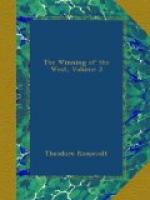Claims to the Northwest.
There was a similar state of affairs in the far Northwest. No New Yorkers lived in the region bounded by the shadowy and wavering lines of the Iroquois conquests. The lands claimed under ancient charters by Massachusetts and Connecticut were occupied by the British and their Indian allies, who held adverse possession. Not a single New England settler lived in them; no New England law had any force in them; no New England soldier had gone or could go thither. They were won by the victory of Wayne and the treaty of Jay. If Massachusetts and Connecticut had stood alone, the lands would never have been yielded to them at all; they could not have enforced their claim, and it would have been scornfully disregarded. The region was won for the United States by the arms and diplomacy of the United States. Whatever of reality there was in the titles of Massachusetts and Connecticut came from the existence and actions of the Federal Union. [Footnote: For this northwestern history see “The Life, Journal, and Correspondence of Manasseh Cutler,” by Wm. Parker Cutler and Julia Perkins Cutler; “The St. Clair Papers,” by W. H. Smith; “The Old Northwest,” by B. A. Hinsdale; “Maryland’s Influence upon Land Cessions,” by Herbert Adams. See also Donaldson’s “Public Domain,” Hildreth’s “History of Washington County,” and the various articles by Poole and others. In Prof. Hinsdale’s excellent book, on p. 200, is a map of the “Territory of the Thirteen Original States in 1783.” This map is accurate enough for Virginia and North Carolina; but the lands in the west put down as belonging to Massachusetts, Connecticut, and Georgia, did not really belong to them at all in 1783; they were held by the British and Spaniards, and were ultimately surrendered to the United States, not to individual States. These States did not surrender the land; they merely surrendered a disputed title to the lands.]
The Non-claimant States.
All the States that did not claim lands beyond the mountains were strenuous in belittling the claims of those that did, and insisted that the title to the western territory should be vested in the Union. Not even the danger from the British armies could keep this question in abeyance, and while the war was at its height the States were engaged in bitter wrangles over the subject; for the weakness of the Federal tie rendered it always probable that the different members of the Union would sulk or quarrel with one another rather than oppose an energetic resistance




